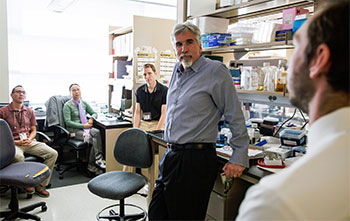Innate Immune Program Builds From Strength
Understanding the world of microbes inside the body

Mark Couch
(May 2017) The GI and Liver Innate Immune Program (GALIIP) plans to build on strengths already on the CU Anschutz Medical Campus to expand understanding of some of the fastest-growing diseases facing society.
Costing the U.S. health system nearly $500 billion annually, gastrointestinal and liver-related diseases are
A common element of these diseases is
“The concept of innate immune response is that it happens much sooner than adaptive response,” said Hugo Rosen, MD, professor of medicine and immunology, head of the Division of Gastroenterology and Hepatology and one of the leaders of GALIIP. “They’re kind of the first line of defense against
“Where an adaptive or T cell response takes four to eight weeks, this happens in hours to days,” he said. “And organs like the gut and the liver are characterized by a very high frequency, or what we call an enrichment, of these innate lymphocytes and nowhere else in the
In recent years, scientists have focused their attention on gaining a better
Sean Colgan,
“In particular, think about the gut,” he said. “The gut interacts with more bacteria, more microbes than any other organ in the body. And in
One of the leaders in that effort, Colgan said, is Catherine Lozupone,
GALIIP also draws on a rich legacy. Work by Norman Pace,
“We have a very large footprint in microbiota analysis,” Colgan said.
The next step is to expand into new areas of discovery, outlined by GALIIP as:
- Mucosal innate immunity. Accumulating evidence indicates that the unique anatomy and complex architecture of the GI tract and liver provide cues that contribute significantly to both disease progression and resolution of mucosal disease. Compartmentalized tissue and microbe populations within the intestine, for example, result in significant metabolic shifts within these tissue microenvironments. During active inflammatory disease, metabolic demands often exceed supply, resulting in localized areas of metabolic stress.
- Microbiota. Advances in DNA sequence-based technologies now permit genetic analysis of complex microbial populations without the need for prior cultivation. These molecular methods of culture-independent microbiology and their recent application to studies of the human GI tract in health and disease have served as a paradigm shift in understanding of host-microbe interactions. Upwards of 40,000 bacterial species are estimated to comprise the collective gastrointestinal microbiome, most of which have not been
charac-terized .
- Hepatic diseases and innate immunity. Innate immunity is critical to the health of the normal liver and central to the pathogenesis of common hepatic disorders, such as non-alcoholic fatty liver disease (NAFLD). Given the epidemic of obesity in our society, NAFLD and subsequent liver fibrosis have emerged as a major morbidity risk. Innate immunity is central to the development of NAFLD. Among the advantages for researchers at the
CU Anschutz Medical Campus are existing repositories of specimens for research and the proximity of clinical centers for adults and children.
 “We have been building repositories of human specimens. So in addition to murine models of disease, we have human models of disease,” said Rosen. “In my lab, we started a repository in 1999 and we now have over 60,000 specimens.
“We have been building repositories of human specimens. So in addition to murine models of disease, we have human models of disease,” said Rosen. “In my lab, we started a repository in 1999 and we now have over 60,000 specimens.
“Using those samples, researchers can look at the populations of cells residing over the liver and ask how many of these cells are autoimmune liver conditions, viral conditions, fibrotic-scar-forming conditions, and interestingly in the liver the predominant population is actually innate lymphocyte population,” he said.
With such knowledge, GALIIP researchers building a better understanding of the vast landscape of the microbiome and why it manifests differently in particular populations.
“One of our big pushes is to understand the differences between liver disease and gut disease in kids and in adults,” Colgan said. “So being on this campus and having Children’s Hospital and University Hospital here and the basic science is a big advantage.”
With the combined insights, GALIIP researchers hope to improve the understanding of the vast landscape of the microbiome.
“You get this genetic foundation in terms of what’s known about certain receptors, or certain pathways, that are regulated genetically, but there is so much more going on within the microenvironment,” Rosen said.